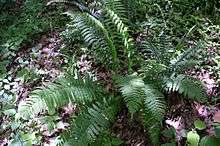Homalosorus
Homalosorus is a genus of fern with only one species, Homalosorus pycnocarpos. Commonly referred to as the narrow-leaved glade fern, narrow-leaved spleenwort, or glade fern, it may also be referred to by its older synonyms Athyrium pycnocarpon and Diplazium pycnocarpon. It is endemic to eastern North America and typically grows in rich woodlands. Once classified in the family Athyriaceae due to its linear, often doubled sori, phylogenetic research has shown that it belongs to the small family Diplaziopsidaceae, whose other three species are native to east Asia.
| Silvery glade fern | |
|---|---|
 | |
| Homalosorus pycnocarpos in rich mesophytic forest, Brown County State Park, Indiana, USA. | |
| Scientific classification | |
| Kingdom: | Plantae |
| Clade: | Tracheophytes |
| Class: | Polypodiopsida |
| Order: | Polypodiales |
| Suborder: | Aspleniineae |
| Family: | Diplaziopsidaceae |
| Genus: | Homalosorus Small ex Pic.Serm. |
| Species: | H. pycnocarpos |
| Binomial name | |
| Homalosorus pycnocarpos (Spreng.) Pic.Serm. | |
| Synonyms | |
| |
Description
Homalosorus pycnocarpos is a tall slender-leaved fern growing as individuals with 5 to 6 leaves. The plant spreads by creeping underground stems allowing a small colony to develop over time. The leaf blade is oblong-lanceolate and once-pinnate. Leaves grow to about 90 cm (36 in) long and 15 cm (6 in) wide. The pinnae are linear and entire. Fertile leaves are similar but erect, narrower than sterile leaves and with longer stipes. The sori are long and narrow in two lines along the underside of a leaf pinna, giving rise to its specific epithet pycnocarpon ('crowded fruits').
Its common name description "narrow-leaved" is reflected in its original specific epithet by André Michaux in 1803: angustifolium (angustus 'narrow' + folium 'leaf'). Michaux classified it in the genus Asplenium.[1]
Distribution
Endemic to eastern North America. Widespread from southern Ontario to the Gulf of Mexico and west to Minnesota and Arkansas. Usually found as isolated plants or colonies. See Flora of North America for distribution map.
Ecology
Grows in lighter parts of mesophytic forests and in ravines in moist but well-drained, neutral to basic soils.
References
- Lloyd H. Snyder, Jr.; James G. Bruce (1 October 1986). Field Guide to the Ferns and Other Pteridophytes of Georgia. University of Georgia Press. p. 118. ISBN 978-0-8203-2385-5. Retrieved 26 September 2013.
External links
| Wikimedia Commons has media related to Homalosorus. |
Further reading
- Cobb, Boughton. (1984). A Field Guide to Ferns and their Related Families of Northeastern and Central North America. Peterson Field Guides.
